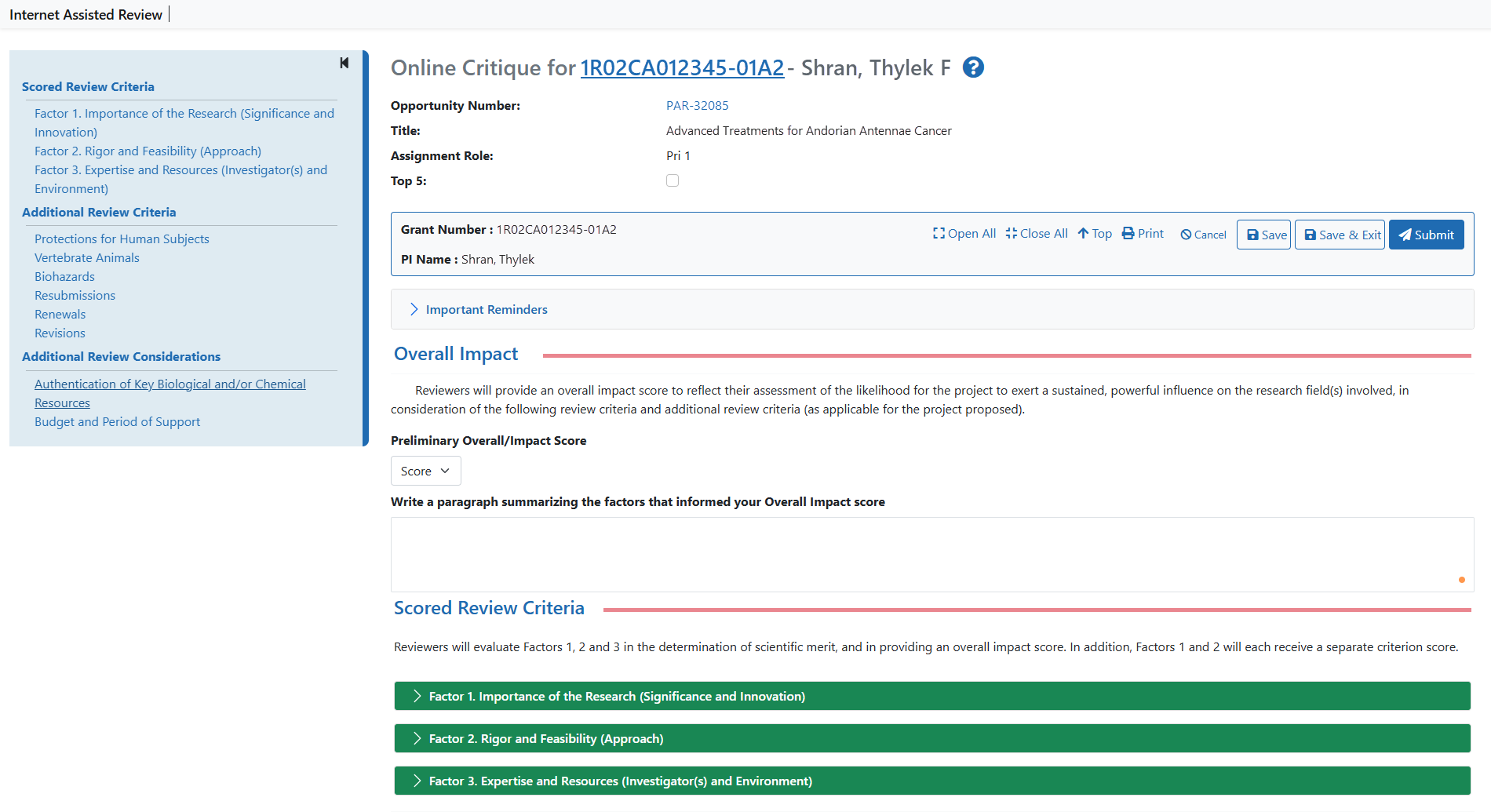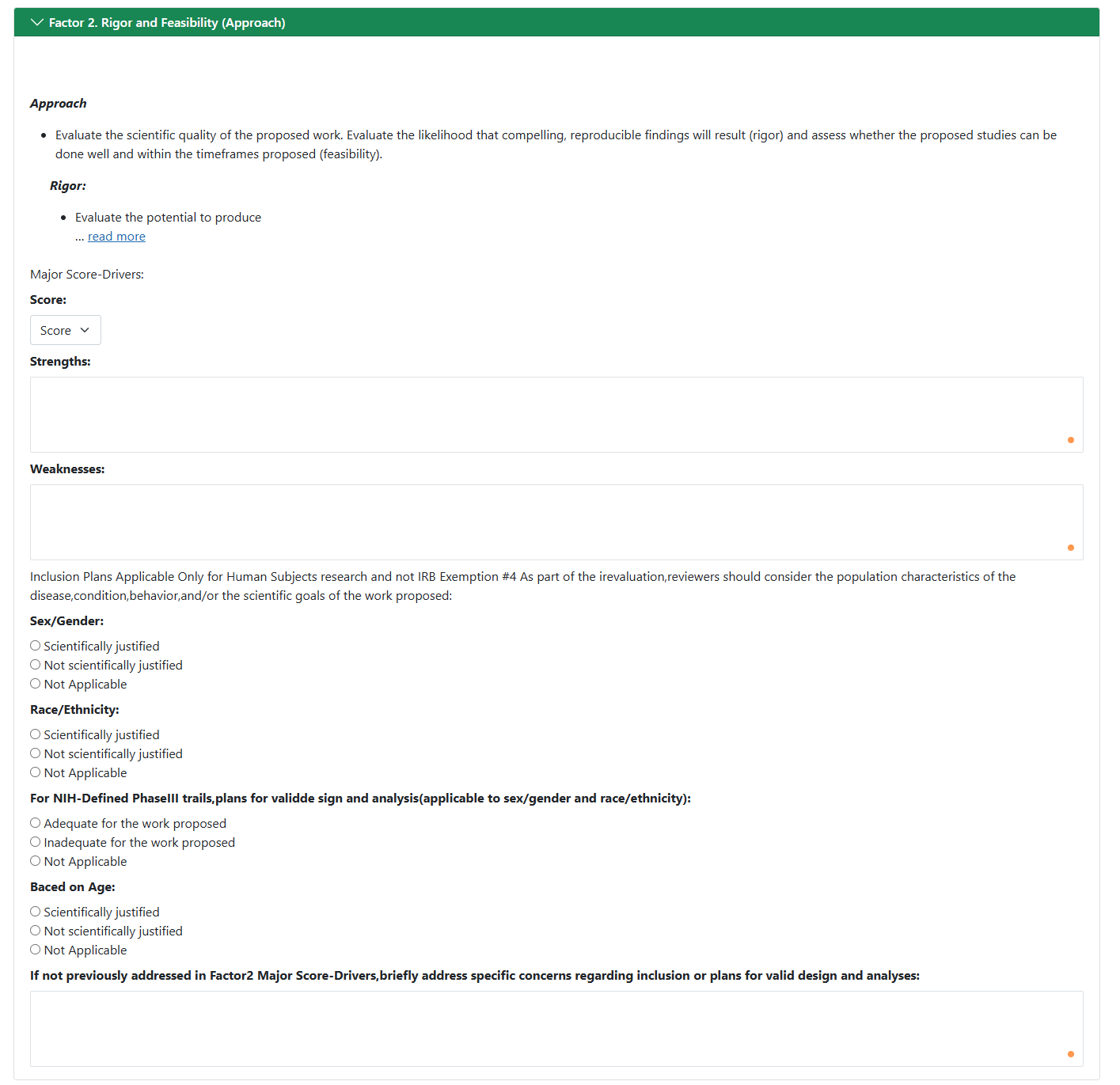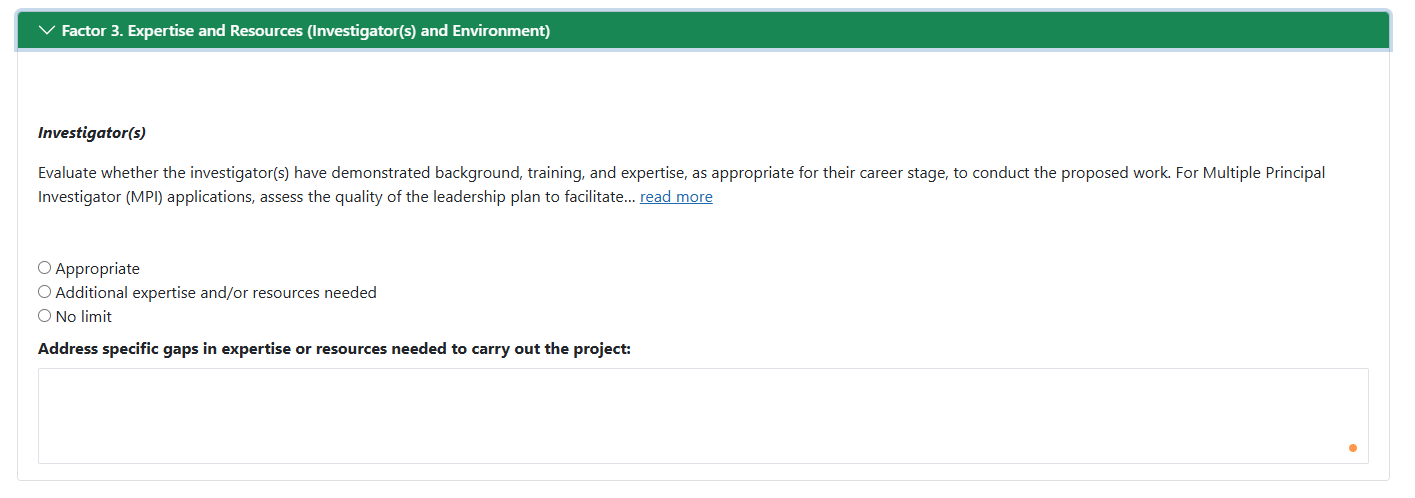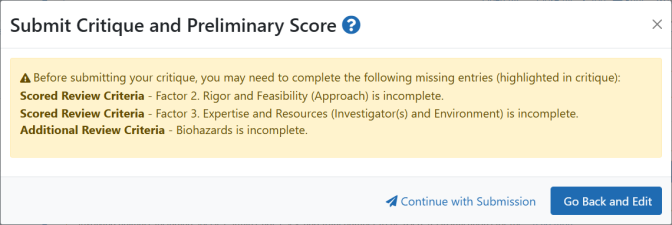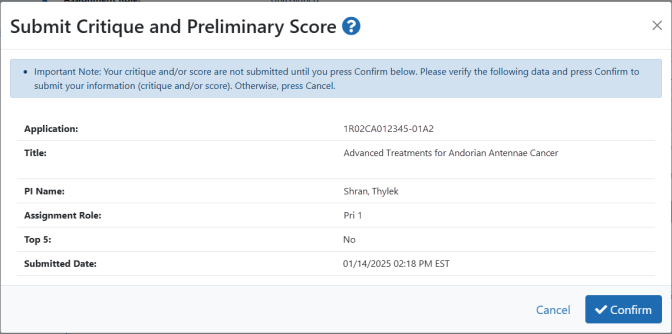Submit Online Critiques & Scores for Reviews using Factor Criteria (Simplified Review Framework)
Online critique submission under SRF, similar to Word-based critique submission, also retains the 5 review criteria but reorganizes them into three factors:
-
Factor 1: Importance of the Research (Significance, Innovation)
-
Factor 2: Rigor and Feasibility (Approach)
-
Factor 2: Expertise and Resources (Investigators and Environment)
To understand more about SRF and the activity codes impacted by SRF, please visit Simplified Peer Review Framework.
Open and Complete the Critique
Follow these steps to complete the online critique:
- Go to the List of Applications or List of My Assigned Applications screen in Internet Assisted Review (IAR).
- In the Application Number column for the application for which you are submitting a critique, click the three-dot ellipses icon and select the Submit Critique option.
- The
 Online Critique screen opens.
Online Critique screen opens.
NOTE: Review the Important Reminders heading by clicking on the heading text Important Reminders in the blue bar. This might contain instructions from the SRO that are relevant for the current meeting.
- Click the green headers to expand each section to fill out the critique. Use the tab key to jump from field to field. For example, there are the three Factors;
- To complete
 Factor 1. Importance of the Research (Significance and Innovation) selected a criterion score from 1 - 9 from the Score dropdown menu. Include comments on strengths and weaknesses of the importance of the research in the corresponding text fields.
Factor 1. Importance of the Research (Significance and Innovation) selected a criterion score from 1 - 9 from the Score dropdown menu. Include comments on strengths and weaknesses of the importance of the research in the corresponding text fields.
-
For
 Factor 2: Rigor and Feasibility (Approach) select a criterion score (1 - 9) from the Score dropdown menu and privide comments on strengths and weaknesses. Additionally, if an inclusion plan is applicable for human subjects research, select appropriate radio button for each radio group. If you have additional concerns, you provide them in the text box provided at the bottom of the section.
Factor 2: Rigor and Feasibility (Approach) select a criterion score (1 - 9) from the Score dropdown menu and privide comments on strengths and weaknesses. Additionally, if an inclusion plan is applicable for human subjects research, select appropriate radio button for each radio group. If you have additional concerns, you provide them in the text box provided at the bottom of the section.
 Factor 3: Expertise and Resources (Investigator(s) and Environment) does not get a criterion score. It is evaluated as either sufficient for the proposed research or not by selecting the appropriate radio button. If the expertise or resources are not appropriate, provide an explanation in the text box provided.
Factor 3: Expertise and Resources (Investigator(s) and Environment) does not get a criterion score. It is evaluated as either sufficient for the proposed research or not by selecting the appropriate radio button. If the expertise or resources are not appropriate, provide an explanation in the text box provided.- For each review criteria, read the specific guidance for the criteria at the top of the editing area by clicking the read more link, which shows all available guidance for the criteria item.
- Enter your comments in text fields. See Editing in a Critique Text Field.
TIP: To ensure you do not inadvertently forget a field, enter N/A in the field if you have no comments for the field. This will also reduce warnings about empty fields when you submit the critique
Editing in a Critique Text Field
When you click in a field, a toolbar appears with formatting tools:

The first six of these are familiar to most users: and are bold, italic, underline, strikethrough, subscript, and superscript. You can hover your cursor over any editing tool to see its name and its keyboard shortcut keys if available.
The less familiar icons are explained below.
|
Formatting Button |
Action |
|---|---|
|
|
Removes all formatting from selected text. |
|
|
Numbered List/Bulleted List tools. Bullet or number the selected text. |
|
|
Special character tool. Opens a Select Special Character window, from which you can choose special characters. While you can copy and paste from other applications to the Online Critique screen, special characters might not be rendered correctly in the final critique if you do so. It is recommended that you use the special character editing tool for inserting special characters to ensure correct rendering of special characters. |
|
|
Undo and redo tools. |
Submit the Critique
-
After you fill out the critique completely, you are ready to submit. In the gray summary box at the top of the Online Critique screen, click the Submit button.

- If any entries are not completed, a
 warning dialog lists the incomplete fields.
warning dialog lists the incomplete fields.
- Click Go Back and Edit.

-
Address incomplete entries as needed. If you are not sure if you are required to complete the section, please work with your SRO for guidance. Click Continue with Submissiononce you have addressed incomplete entries or discussed with your SRO. You are able to submit your critique with the incomplete sections.
- Review the information and click the Confirm button to complete the online critique submission.
A message appears at the top of the screen indicating successful submission.
message appears at the top of the screen indicating successful submission.
At this point, a submitted online critique is saved into the system. If you later decide you want to edit the submission, you can do so; see Make Changes to a Critique After Submitting.
You can view your own critiques and scores as well as those of other reviewers (when permitted) once you have submitted them. The process by which critiques are viewed differs from phase to phase. Refer to Viewing Critiques for a description of the phase-specific method of viewing critiques.
For more information related to this topic, see About Online Critiques and Navigating the Online Critique Screen.
